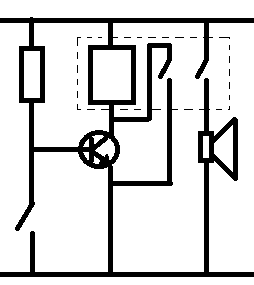Another thing about the festive season is that assuming you were lucky you probably have a whole load of new stuff.
Obviously you like your new stuff, and don't want to loose your new stuff, so we'll look at some protection systems for your stuff.
An absolute classic of beginner electronics, A burglar alarm.
We start with a fairly circuit, it looks a bit like the amplifier that was made sometime last year, except instead of a resistor there's a switch in the circuit, the switch is the kind that you'd put on a window or door frame to detect entry.
We see that in standby mode the normally closed switch grounds the base of the transistor meaning that it is in the cut-off region and does not conduct.
As the transistor is not conducting the relay is not energised and the buzzer does not sound.Now some one comes and opens the window. now the base of the transistor in not grounded and instead is at a high level, the transistor now begins conducting and the relay is energised, causing the buzzer to sound.
Latching
The trouble with the circuit above is that as soon as the would be burglar closes the window (maybe with them on the inside) the transistor is grounded again, and so stops conducting and therefore the relay and buzzer go off.
What we need is a way of turning on the relay and having it stay on.
the term for this is having the relay latch on.
It is possible to get relays that latch automatically, but these tend to be expensive, so we're now going to show how we can turn a regular relay with two switches in it. (double pole)
What we do is place one of the switches in parallel with the collector and emitter connections on the transistor.
When the window switch closes again the transistor stops conducting but the closed contact in the relay doesn't, and because this path still exists the relay is energised so the alarm stays on.
To reset the circuit all you need to do is momentarily break the power going to the relay then the contacts will open and there would be no path to energise the relay so the alarm stops also.


No comments:
Post a Comment